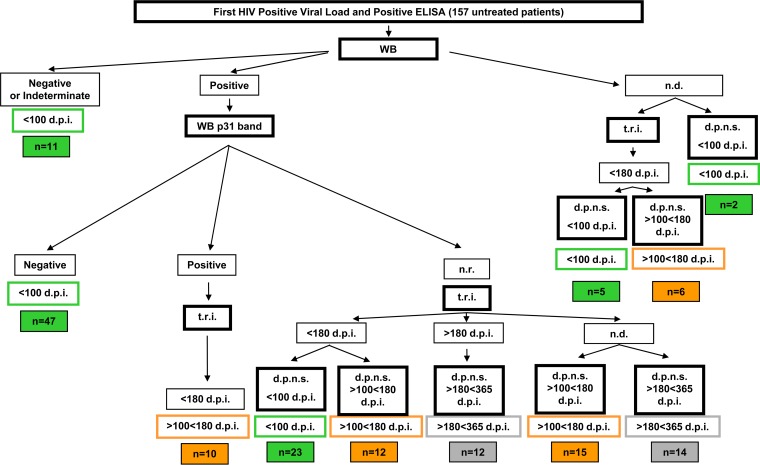FIG 1.
Algorithm for dating of HIV-1 infection in patient sera (<100 dpi, >100 but <180 dpi, and >180 but <365 dpi). d.p.n.s., days postnegative serology; t.r.i., test for recent infection; n.d., not done; n.r., not reported. The following categories were used for samples from patients infected for <100 dpi: (i) negative or indeterminate Western blot (WB); (ii) positive Western blot with a negative p31 band; (iii) positive Western blot with no data for the p31 band and t.r.i. indicating fewer than 180 days of infection, and d.p.n.s. indicating fewer than 100 days of infection; (iv) no Western blot information, with t.r.i. indicating less than 180 days of infection and d.p.n.s. indicating less than 100 days of infection; and (v) d.p.n.s. within 100 days prior to sampling. The following categories were used for samples from patients infected for 100 to 180 dpi: (i) positive Western blot with a positive p31 band and a t.r.i. indicating less than 180 days of infection; (ii) positive Western blot with no data for the p31 band, a t.r.i. indicating less than 180 days of infection, and a d.p.n.s. indicating 100 to 180 days prior to the sampling; (iii) positive Western blot with no p31 band data reported, no t.r.i. data, and a d.p.n.s. of within 100 to 180 days prior to the sampling; and (iv) no Western blot information, t.r.i. indicating less than 180 days of infection, and a d.p.n.s. within 100 to 180 days prior to the sampling. The following categories were used for samples of patients infected for 180 to 365 dpi: (i) positive Western blot with no data for the p31 band, t.r.i. indicating more than 180 days of infection, and a documented previous negative serology within 180 to 365 days prior to sampling; (ii) a positive Western blot with no data for the p31 band, no t.r.i. data, and a d.p.n.s. of within 180 to 365 days prior to sampling.

